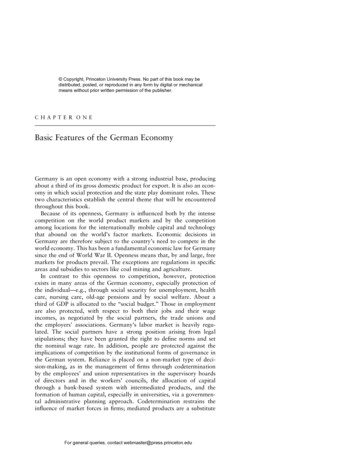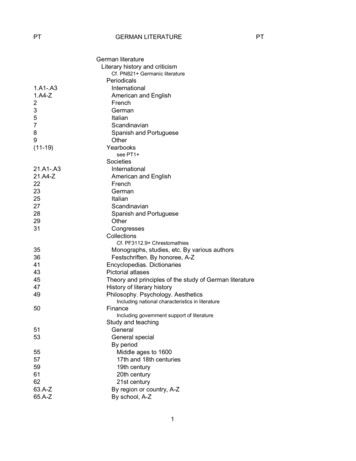
Transcription
Copyright, Princeton University Press. No part of this book may bedistributed, posted, or reproduced in any form by digital or mechanicalmeans without prior written permission of the publisher.C H A P T E R O N EBasic Features of the German EconomyGermany is an open economy with a strong industrial base, producingabout a third of its gross domestic product for export. It is also an economy in which social protection and the state play dominant roles. Thesetwo characteristics establish the central theme that will be encounteredthroughout this book.Because of its openness, Germany is influenced both by the intensecompetition on the world product markets and by the competitionamong locations for the internationally mobile capital and technologythat abound on the world’s factor markets. Economic decisions inGermany are therefore subject to the country’s need to compete in theworld economy. This has been a fundamental economic law for Germanysince the end of World War II. Openness means that, by and large, freemarkets for products prevail. The exceptions are regulations in specificareas and subsidies to sectors like coal mining and agriculture.In contrast to this openness to competition, however, protectionexists in many areas of the German economy, especially protection ofthe individual—e.g., through social security for unemployment, healthcare, nursing care, old-age pensions and by social welfare. About athird of GDP is allocated to the ‘‘social budget.’’ Those in employmentare also protected, with respect to both their jobs and their wageincomes, as negotiated by the social partners, the trade unions andthe employers’ associations. Germany’s labor market is heavily regulated. The social partners have a strong position arising from legalstipulations; they have been granted the right to define norms and setthe nominal wage rate. In addition, people are protected against theimplications of competition by the institutional forms of governance inthe German system. Reliance is placed on a non-market type of decision-making, as in the management of firms through codeterminationby the employees’ and union representatives in the supervisory boardsof directors and in the workers’ councils, the allocation of capitalthrough a bank-based system with intermediated products, and theformation of human capital, especially in universities, via a governmental administrative planning approach. Codetermination restrains theinfluence of market forces in firms; mediated products are a substituteFor general queries, contact webmaster@press.princeton.edu
Copyright, Princeton University Press. No part of this book may bedistributed, posted, or reproduced in any form by digital or mechanicalmeans without prior written permission of the publisher.2CHAPTER ONEfor market products in the capital market, and human capital formationis government dominated.The government has a strong impact on the German economy in otherareas as well: half of GDP (including social security) passes through it. Inall of these domains, consensus plays a central role in the system ofgovernance. The government itself is organized as a federal state, withtax revenue shared between the federal states (distributive federalism)and with two parliamentary chambers, one of which—the Bundesrat—represents the federal states (Länder). Many laws require the concurrenceof both chambers, so that here too consensus is required.The Historic Road to ProsperityWith a population of 82 million inhabitants and a GDP of e2.1 billion,Germany is Europe’s largest economy, producing nearly a quarter of theEuropean Union’s GDP and nearly a third of the GDP of the eurocurrency area (data for 2002). It is the third largest economy in theworld, accounting for 6 percent of world GDP (2000)—one fifth themagnitude of the US share and less than half that of Japan. Accountingfor 9.5 percent of world exports, Germany comes second in world tradeafter the United States.GDP per capita is e26 000 in current values (2002), slightly above theEU-15 average (104 percent at current prices) and at about the same levelas France, Italy, and the United Kingdom, but somewhat lower than someof the smaller EU members, e.g., Austria, Denmark, the Netherlands, andIreland. GDP per capita at current prices and at the current exchange rateis about the same as that of Japan, but lower than that of other countries,e.g., the United States (at 142 percent of the EU level), Switzerland, andNorway. According to calculations of the World Bank, 1 Germany’s relative ranking in GDP per capita in current prices stands at position 20, andin purchasing power parity at 21. Without question, Germany belongs tothe rich industrialized countries of the world—in other words, the highincome countries.Germany has experienced an admirable increase in prosperity. Its percapita GDP of about e4350 in 1950 rose by a factor of nearly six toe24 057 in 2002 in constant prices. 2 GDP growth rates were high inthe first three decades after World War II, at 8.2 percent in the 1950s,4.4 percent in the 1960s, and 2.8 percent in the 1970s. It also enjoyed ahigh growth rate in labor productivity per hour, with rates of 5.3 percentin the 1960s and 3.7 percent in the 1970s (table 1.1).12World Bank (2002: table 11).DM8535.88 (in constant 1991 prices), equivalent to e4364.33.For general queries, contact webmaster@press.princeton.edu
Copyright, Princeton University Press. No part of this book may bedistributed, posted, or reproduced in any form by digital or mechanicalmeans without prior written permission of the publisher.3BASIC FEATURES OF THE GERMAN ECONOMYTable 1.1Growth rates of GDP per capita, GDP and labor productivity per hour a1950–60 1960–70 1970–80 1980–90 1991–2000 2000–2003GDP/capitaGDPLabor productivityper hour7.18.24.7 ce: Federal Statistical Office, Volkswirtschaftliche Gesamtrechnungen, Fachserie 18,Reihe 1.2.aCalculated as an exponential growth rate for a decade, i.e., with 1980 and 1990 as theend point (10 periods).bProductivity per capita.The first three decades after World War II were devoted to the processof catching up with the United States. The country’s institutional setupwas beneficial for growth. In 1948 Ludwig Erhard freed prices, whichended the rationing of the product markets. Quickly, the economy wasopened up to international competition. Nationalization of basic industries, especially coal and steel, was not pursued, although this had beenconsidered, temporarily, even by the Christian Democrats. Establishingthe Deutschmark as a stable currency made possible convertibility, firstfor foreigners and then for residents. Germans, hard-working andsuccess-oriented, saw their dreams coming true—the first vacationabroad, the first motorcycle, their own home. In a way, in these yearsof the Wirtschaftswunder Germans experienced positive surprises, in thatthe economic system generated a higher income and a larger bundle ofconsumption goods than people had hoped for. Even wages increased bymore in real terms than the social partners had negotiated; there was apositive wage drift through the market forces. This was a period of positive surprise. In such a period, today’s success is the fuel for greater efforttomorrow.A Lower Growth Path since 1980The two oil crises in 1973/74 and 1979/80, though causing a seriousshock to the German economy with the two ensuing recessions, did notseem to have changed the pattern of growth, at first; three million additional jobs were generated in the 1980s, and many economic indicatorsimproved in the second part of that decade. Nevertheless the year 1980,For general queries, contact webmaster@press.princeton.edu
Copyright, Princeton University Press. No part of this book may bedistributed, posted, or reproduced in any form by digital or mechanicalmeans without prior written permission of the publisher.4CHAPTER ONEwith the second oil shock, and the following recession in 1982 can beviewed as a turning point of Germany’s economic development. Theincrease in GDP per capita became smaller, falling to 2.0 percent in the1980s, 3 and the economy moved to a lower potential growth path ofaround 2.5 percent. Labor productivity was growing at a similarly lowrate after 1980, by which time productivity growth had halved relative tothe 1960s and was substantially lower than in the 1970s. The economicsystem had changed its economic properties without the politicians andthe public really noticing.Looking at economic growth for the united Germany from 1991 (thefirst year for which we have GDP data for the reunified country) onward,the annual growth rate for the period 1991–2000 was only 1.3 percent.This figure is somewhat distorted, since the high growth rates of 1990 (inWest Germany) and of 1991 (in reunified Germany) are not included. Ifone were to take the 1990 West German GDP as the base value, theannual GDP growth rate for the period 1990–2000 would amount to3.0 percent. However in this procedure, unification or the addition ofEast Germany to the German economy would be interpreted as growth.This rate would be way too high. If we include the West German growthrate of 1991 (5.1 percent), the growth rate for the period 1990–2000would amount to 2.0 percent instead of 1.3 for the period 1991–2000.For 1995–2002 these statistical problems are no longer relevant; moreover, the deep recession of 1992 does not affect these data; for this periodGermany’s GDP growth rate was only 1.2 percent.Over a longer duration of five decades, the high rates of about 8 percentor more in the years between 1951–56, 1959, and 1960 could no longerbe reached. Since 1980, rates over 4 percent were registered only in 1990and 1991, the years of the German unification boom (figure 1.1). TheGDP growth rate continued its decline. Even if a recovery in 2004 and2005 changes the bleak picture somewhat, there is a clear secular trend ofa steadily decreasing growth rate.An Open EconomyA widely accepted principle of German economic strategy has been theopenness of its economy, that is, its free trade policy. In spite of the subsidization of some sectors such as coal mining and agriculture, protectionism3Growth rates are calculated according to the formular ¼ ½ðY90 Y80 Þð0:1 nÞ 2 1 100where n is the number of periods and, as an example, 90 and 80 are the end- and start-yearsof the period.For general queries, contact webmaster@press.princeton.edu
Copyright, Princeton University Press. No part of this book may bedistributed, posted, or reproduced in any form by digital or mechanicalmeans without prior written permission of the publisher.BASIC FEATURES OF THE GERMAN ECONOMY5Figure 1.1 Annual growth rates, averages for decades. Until 1990, data for WestGermany; since 1991, data for unified Germany. Source: Federal Statistical Office.was never attractive in post-war Germany. Having joined the GATT in1951, and with current trade policy being implemented at the Europeanlevel, the principle of an open economy is by now well entrenched.Germany has an export share of 35.5 percent of its GDP (2002). Theoverwhelming part of its exports—42 percent—go into the euro area and55 percent are sold to the 15 EU countries (not all EU countries are part ofthe euro area); if the ten new member states of European Union enlargement are included, this share would be 64 percent. About 10 percent ofexports are bought by the United States, another 10 percent by otherindustrialized countries, and still another 10 percent by the countries ofcentral and eastern Europe (including the new EU members). Smallerportions are shipped to South East Asia (5 percent) and Latin America(2.5 percent) (2001).The share of West German exports in its GDP increased steadily fromthe end of World War II, from 13.7 percent in 1950 to 18.0 percent in1951, 19.0 percent in 1960, 4 21.2 percent in 1970, 26.4 percent in 1980,and 32.1 in 1990 (figure 1.2). It then fell for the united Germany to 22.8percent in 1993 before rising again beyond its 1990 level. Clearly,Germany has successfully integrated itself into the international divisionof labor. Free trade has been the vehicle by which it has managed toincrease its well-being.Germany’s technology-based industry provides almost 90 percent ofthe country’s exports, of which a large part is investment goods: 594There is a structural break in the data in 1960. Older data for 1960 show a larger share.For general queries, contact webmaster@press.princeton.edu
Copyright, Princeton University Press. No part of this book may bedistributed, posted, or reproduced in any form by digital or mechanicalmeans without prior written permission of the publisher.6CHAPTER ONEFigure 1.2 Share of exports, 1950-2002 (percent of GDP). Calculated asnominal exports to nominal GDP. At 1960 there is a structural break in thedata. Source: Federal Statistical Office, Series 7 and 18.percent of exports stem from four industrial sectors—machine building,automobile, chemicals, and electro-technical products; only 10 percent ofexports are services.Germany has hardly any natural resources except for coal, wood, and afew minerals. Its industrial base traditionally depended on the engineeringideas and innovative performance, on entrepreneurial spirit, on the organizational capabilities of its people, and on the skills and the effort of itsworkers. Raw materials and energy had to, and still have to, be imported;energy accounts for 5 percent of total imports. Foodstuffs make up 11percent of all imports, 9 percent are intermediate products. The bulk ofimports are consumer goods and investment goods. This holds especiallyfor trade within the same sector (intra-industry or intra-sectoral trade),where many products, from cars to investment goods, are similar and thusrepresent both export goods and import goods. The coefficient of intraindustry trade at the two-digit level is at 0.74, higher than in for the UnitedStates (0.68) and Japan (0.45) (data for 2000).The current account was slightly negative in the 1990s, but the balancehas been in a surplus since 2001. A larger surplus, amounting to over 4percent of GDP, was reached in the late 1980s when Germany was a netcapital exporter like Japan. As a result of German unification, there was aswing in the external position, from a positive 4.6 percent of GDP in 1989to a negative 1.2 percent in 1991.For general queries, contact webmaster@press.princeton.edu
Copyright, Princeton University Press. No part of this book may bedistributed, posted, or reproduced in any form by digital or mechanicalmeans without prior written permission of the publisher.BASIC FEATURES OF THE GERMAN ECONOMY7The contribution of trade to growth can be interpreted from both thedemand side and the supply side. In the short run, and viewed from thedemand side, the contribution of trade stems from net exports, i.e., from asurplus in the trade balance. Positive net exports have a positive impact,as exports stimulate aggregate demand and offset imports, which represent a leakage in the traditional Keynesian analysis. From this point ofview, a positive trade balance represents a positive contribution to thegrowth rate, its contribution being measured by the Lundberg component. A negative trade balance reduces the growth rate, and a balancedtrade account has no demand effect on growth. Traditionally, in theGerman case an upswing in the business cycle is stimulated by an increasein export demand, which is then followed by a pick-up of investment andeventually leads to less uncertainty, in terms of employment, and tohigher income, so that consumer demand increases as well. In the longrun, and viewed from the supply side, trade has an impact on growththrough different channels. Imports increase the set of available consumption goods; they also enlarge the production capacity of the economy bymaking intermediate inputs, investment goods and new technology available to the firms. Trade allows specialization gains and enhances theaccumulation of growth factors.The Enterprise SectorLooking at the production side of the German economy, 22.2 percent oftotal gross value added came from industry in 2002, a further 6.8 percentfrom the other producing sectors, and 1.1 percent from agriculture. Thebulk of gross value added, 70.1 percent, was generated in the servicesector. Within the service sector, 30.4 percent came from financing, housing, and services to firms, 18.0 percent from retail, trading, hotels, andrestaurants and 6.1 percent from public sector services.Of the German firms, the larger German multinationals such as Allianz, Bayer, BMW, DaimlerChrysler, Siemens, and Volkswagen are recognized internationally. Out of the 20 largest firms as measured by theiremployees, 8 are in the export-oriented German industry, 3 of which arecar producers (table 1.2); 4 are in the service sector; and another 4 inretail and trading. A few of these, like Lufthansa, are multinationals, butmost are oriented toward the home market. Together with the two largeenergy suppliers on this list of the 20 largest German firms, the nontradable sector is strongly represented.It is important to make a clear distinction between the performance ofthe German firms and the status of the German economy. The Germanmultinationals generate a large part of their value added abroad; thisFor general queries, contact webmaster@press.princeton.edu
Copyright, Princeton University Press. No part of this book may bedistributed, posted, or reproduced in any form by digital or mechanicalmeans without prior written permission of the publisher.8CHAPTER ONETable 1.2The twenty largest German SiemensDeutsche PostDaimlerChryslerVolkswagenDeutsche TelekomDeutsche ent 1231101061019489Source: Frankfurter Allgemeine Zeitung, July 8, 2003.production is not included in the German GDP, whereas production byforeign firms in Germany does count towards the German GDP. Likewise, employment by German firms is not identical to employment inGermany. Whereas German firms are efficient according to internationalstandards, this does not imply that targets of economic policy such as fullemployment are met in Germany.It would be misleading to attempt to understand Germany’s enterprisesector by looking solely at these 20 large firms. Among the larger firms areother international players, such as Bertelsmann with 81 000 employees,Deutsche Bank with 77 000 employees, and MAN with 75 000 employees. The ranks of firms smaller in size are densely populated with, forinstance, Boehringer Ingelheim at position 25 of the industrial firms interms of revenue (32 000 employees), Freudenberg, a family-dominatedenterprise (28 000 employees) at position 49, Braun (29 000) at rank 66,Miele (15 000) at position 80, and Brose Fahrzeugbau (7000), a firmproducing car seats and car doors, at ranking 100.Analyzing the structure of firms in more detail, and looking at itfrom the revenue side, 2.6 million out of 2.9 million enterprises, orFor general queries, contact webmaster@press.princeton.edu
Copyright, Princeton University Press. No part of this book may bedistributed, posted, or reproduced in any form by digital or mechanicalmeans without prior written permission of the publisher.BASIC FEATURES OF THE GERMAN ECONOMY989.4 percent, have an annual revenue of less than e1 million (data for2000); 300 000 enterprises, or 10.3 percent, have an annual revenue ofbetween 1 million and 50 million euro; 7700 companies, or 0.3 percent,have a revenue of more than 50 million euro. From the point of view ofemployment, there are 2.15 million businesses 5 paying social securitycontributions for their employees (table 1.3). Of these, 18.2 percent arebusinesses with fewer than 10 employees, 60.2 percent businessesemploying between 10 and 499 people, and 21.6 percent businessesemploying 500 or more.There is no doubt that small and medium-sized firms play an importantrole in the German economy. Enterprises with an annual revenue of lessthan e50 million account for 43.2 percent of total revenue of all firms;businesses with less 500 employees make up 78.4 percent of total employment according to the social security statistics. The role of small andmedium-sized firms for total employment becomes even more apparentif employees exempted from social security, especially the self employed,are taken into consideration. Furthermore, small and medium-sized businesses train more than 80 percent of all apprentices and are also animportant reservoir for upcoming entrepreneurs.Small and medium-sized firms make up the Mittelstand. In a narrowinterpretation, the Mittelstand may be defined as all those firms with anannual revenue of e50 million or less, or with fewer than 500 employees.In a broader interpretation, however, the concept of ‘‘Mittelstand’’includes larger firms and implies other characteristics as well. One isthat in these firms private ownership of the entrepreneur plays an important role, and that the owner-entrepreneur is the driving force of theenterprise. The legal form of such firms often is not a stock company,but another option of limiting liability, such as a limited liabilitycompany (GmbH) or the alternative with more personal liability, anon-incorporated company (e.g., a sole proprietorship or partnershipwith individual liability) where transparency requirements are less strict.As a rule, the more important firms of the Mittelstand are technologicalspecialists in their field; they are built around a technological idea, oftenstemming from the owner-entrepreneur or developed further by him.Whereas some of the medium-sized firms are outsourced legal units oflarger firms, or may be completely dependent on a single buyer as in theautomobile industry, 6 quite a few have their own international independent position. This applies to, for example, medium-sized enterprises like5The term ‘‘business’’ is here used for the German term Betrieb. Betrieb is the economicunit of an enterprise at a location. A Betrieb may be part of an enterprise, the legal unit, or itmay be an enterprise itself.6How important this group of the Mittelstand is, relative to the dependent firms, especially in the automobile industry, is hard to say.For general queries, contact webmaster@press.princeton.edu
Copyright, Princeton University Press. No part of this book may bedistributed, posted, or reproduced in any form by digital or mechanicalmeans without prior written permission of the publisher.10CHAPTER ONETable 1.3Businesses in Germany according to size, 2000 aEmployeesSmall businesses1–9Medium-sized businesses10–1920–4950–99100–499Large businesses500 and moreTotalNumber ofbusinessesNumber ofemployees1 728 7165 064 101416 499205 706129 29646 44235 055162336Percent ofemployees18.2759 991756 042908 517204 874890 55860.29.914.011.524.84 9806 001 53221.62 150 19527 825 624100Source: German Council of Economic Advisors (2002), Annual Report 2002/03, p. 220.aEmployees paying social security contributions in businesses.the saw producer Stihl, the hydraulic systems producer Sauer-Danfoss,the investment good producer Trumph, the cigarette machine makerHauni, the producer of furniture machines Homag, and the tunnelingmachines producer and operator Herrenknecht. These are all firms thatemploy between 7000 and 1200 people and have an annual revenue ofbetween e1.5 and e0.3 billion per year. Most of them have a market nichein the world market for a very specific product, normally in machineconstruction.The Mittelstand has been called the backbone of the German economy.Although it is hard to imagine German industry as consisting of the firmsof the Mittelstand alone, without the larger players, the description ofthem as a backbone seems justified when one looks at employment. TheMittelstand is also unique in the sense that, instead of having hiredmanagers, as in the incorporated large enterprises, entrepreneurial effortof the owner-entrepreneur plays a decisive role. Politically, this group ismore sensitive to changes in taxation or regulation than, say, themanagers of large stock companies. There tends to be a more directresponse from the Mittelstand to changes in governmental policy suchas taxation and regulation. Here indeed may lie an important differencebetween the reality of the German economy and the economic drawingboard of quite a few governmental interventionists and governmentaldecision makers. But it seems that this reality, i.e., the existence of aFor general queries, contact webmaster@press.princeton.edu
Copyright, Princeton University Press. No part of this book may bedistributed, posted, or reproduced in any form by digital or mechanicalmeans without prior written permission of the publisher.BASIC FEATURES OF THE GERMAN ECONOMY11large group of small and medium-sized firms with their entrepreneurs, istypical for other countries in Europe as well, including France, Italy, andthe United Kingdom.Some Macroeconomic DataViewing the German economy through the macroeconomic looking glass,consumption demand of private households accounts for 57 percent ofaggregate demand on the expenditure side of GDP; consumption demandof government is 19 percent, and investment demand is 18 percent (datafor 2002). Net exports or the trade balance, 7 the remaining componentsof aggregate demand, account for nearly 4 percent of GDP.The major part of the e379 billion of investment in 2002 is in buildings(about 57 percent), while about 40 percent is for investment in equipment—the most volatile element of investment, and at the same time thedriving force in the ups and downs of the business cycle. Investment heremeans gross investment, including the replacement of existing capital,financed from depreciation; net investment is normally one quarter ofgross investment.The tax share is 23.2 percent of GDP; taxes and contributions to thesocial security system make up 40.8 percent; and the share of governmentspending is 49.2 percent. The budget deficit has increased in recent years,amounting to 3.9 percent of GDP in 2003. Social absorption is high: thesocial budget, which encompasses all expenditures with a social objective, absorbs one third of what is annually produced. Government debt,at 64.2 percent of GDP in 2003, has doubled in the 1990s.National income, i.e., GDP minus depreciations and production taxesplus subsidies, was e1.57 billion (2002), of which 82 percent went tolabor (including the self-employed) and about 70 percent to the dependently employed; the remainder was interest income and profits of firms.The disposable income of households, i.e., national income minus directtaxes and net contributions to social security (contributions minus transfers received), is e1.3 billion. This goes on consumption and savings.Households save 10.8 percent of their disposable income (2003).Drawing a rather broad picture and not going too much into thedetails, savings of the private sector (households and firms), includingdepreciation, amounted to 22.5 percent of GDP (e474.84 billion 8) in2002, whereas investment of the private sector was 16.5 percent(e346.85 billion). Excess savings of the private sector of 6 percent ofGDP (e127.99 billion) finance a budget deficit of government of78Note that net exports are not identical to the current account.Statistisches Bundesamt, Series l. 18, no. 1.2, table p. 25For general queries, contact webmaster@press.princeton.edu
Copyright, Princeton University Press. No part of this book may bedistributed, posted, or reproduced in any form by digital or mechanicalmeans without prior written permission of the publisher.12CHAPTER ONE3.6 percent of GDP (e76.19 billion), i.e., its dissaving, and the currentaccount surplus of 2.4 percent (e50.39 billion). Note that the budgetdeficit of the government is used partly to finance government investment. The relationship described here reflects the external financingconstraint of the economy, well known to students of internationaleconomics, namely S 2 I 2 D ¼ CA; where S and I are gross savingsand gross investment of the private sector, D is the government’sbudget deficit, and CA is the current account. In our figures for2002, this equation reads: 22:5 2 16:5 2 3:6 ¼ 2:4: Note that, unlikethe United States, Germany does not have a twin deficit in the publicbudget and in the current account.EmploymentGermany has 38.3 million employees, including 4.1 million selfemployed (2003). That means that less than 50 percent of the populationis working. The participation rate, calculated as those in work plus theunemployed as a proportion of the entire population, stands at 51percent. The participation rate of women, calculated as the employedplus unemployed in the 15–65 age group as a proportion of the totalnumber of women in that age group, is much lower than that of men(65 vs 80 percent, respectively). Therefore, there is a potential for anincrease in the supply of labor. Of the 34.3 million who were dependentlyemployed in 2003, 24.6 million were fully employed and 9.3 were working part-time, implying a part-time ratio of 27 percent.Unemployment stood at 4.4 million in 2003, or 10.5 percent of allemployable persons, according to the German definition of unemployment. This amounts to 9.3 percent under the internationally standardizedEU calculation. Unemployment in eastern Germany was 18.6 percent. Inmid-2003 unemployment was highest in the labor office district ofNeubrandenburg in Mecklenburg-West Pomerania at 24.8 percent,while the lowest rate was in Freising, Bavaria, at 4.1 percent. The laboroffice district of Suhl in Thuringia had the lowest unemployment rate
Jul 08, 2003 · Basic Features of the German Economy Germany is an open economy with a strong industrial base, producing about a third of its gross domestic product for export. It is also an econ-omy in which social protection and the state play dominant roles. These two characteristics establish the cen











